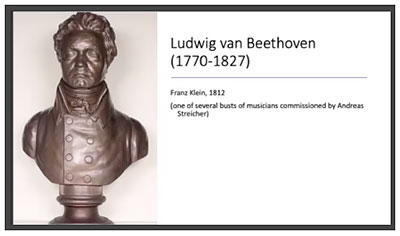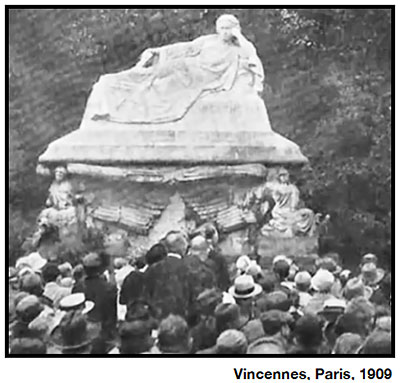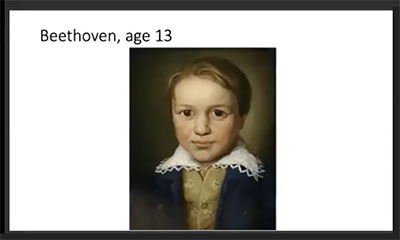Music Educators Association of New Jersey
Serving teachers and students since 1927


Dr. Aaron Wunsch
February 18, 2021

In his fascinating chronological examination of innovations in Beethoven’s sonatas, Dr. Aaron Wunsch showed how Beethoven moved beyond Classical conventions in composing and performing. The performance/lecture included commentary, playing of sonata excerpts along with displays of the excerpts’ scores, and illustrations. Richard Allaway was MEA’s Zoom facilitator. Dr. Wunsch was introduced by Ana Berschadsky, of the MEA Program Committee. Dr. Wunsch studied at Yale (B.M.), the Mozarteum at Salzburg (Fulbright Fellowship), and the Juilliard School (M.M., D.M.A.). He is a faculty member of The Juilliard School, where he teaches keyboard studies and music history and is the artistic director of the Music Mondays concert series in New York. Learn more about him Here.
Some consider the thirty-two sonatas of Ludwig van Beethoven (1770-1827) to be “the pianist’s bible.” Unlike another “bible,” Bach’s “Well-tempered Clavier,” a collection of similar pieces, the Beethoven Sonatas is a collection of individual works that progressively expand the range of expression, drama, forms, keyboard textures, and technical demands. The first sonatas, (Opus 3, Nos. 1, 2, and 3), were dedicated to Haydn, a tribute to Beethoven’s Classical teacher.
A realistic bust of Beethoven by Franz Klein (of 1812) contrasted sharply with a sculpture of a highly idealized, godlike Beethoven. Such was the composer’s mystique. But from musical and historical perspectives, Beethoven was quite human. Self-critical, he wrote in 1804, “My piano music makes the worst impression on me.” He had already written the Pathétique (Opus 13, in 1798/99) and the Waldstein (Opus 53, in 1803/04).


Beethoven’s earliest music studies were grueling daily violin and piano lessons from his father Johann, a court musician. The boy loved to improvise and would stay up late to play for himself. He probably played on a clavichord, a soft instrument with tangent mechanisms that could produce bebung (trembling sound). At age ten, Beethoven began lessons with Christian Gottlob Neefe. He studied the “Well-tempered Clavier” and C.P.E. Bach’s “Essay on the True Art of Playing Keyboard Instruments.” But newer music of Muzio Clementi and others required new keyboard techniques. How would Beethoven acquire them? Although he aspired to perform, he never received training from an expert pianist. “Beethoven found his own way,” Dr. Wunsch said.

Improvising was an essential keyboard skill. In a popular “rule of the octave” exercise, chords were played in the treble above a one octave ascending or descending scale. The method included related drills in cadences and keyboard patterns. In Sonata in F Major, Opus 10 No. 2, mm.5-10, a keyboard progression above an ascending bass is reminiscent of that exercise. But here “the chords are entirely in the bass and the melody is innovative. The design is fundamental, but what Beethoven does with it is where genius is manifest,” Aaron Wunsch declared.
In 1782, Maxmilian Franz, elector of Bonn, sponsored Beethoven’s journey to Vienna for musical study, but his stay was cut short by the death of Beethoven’s mother. Count Waldstein would sponsor Beethoven’s study with Haydn in Vienna in 1792 “to receive Mozart’s spirit from Haydn’s hands.” Vienna offered great performing and teaching opportunities. Dr. Wunsch commented, “The piano sonata was a domestic genre.” Sonatas and pianists were showcased in private concerts in palatial homes. These events might feature keyboard “duels,” which pitted one artist against another. Beethoven’s performances were memorable for the emotion he infused in the music, not for his precision. A critique noted, “he lacks clean playing but he plays with feeling and daring.”

As early as Sonata in A Major, Op.2 No. 2, passages require a new virtuosity. See, at m. 32, the sudden introduction of rapid triplets in the bass and then look at m. 84, a section with rapid broken octaves. As interest in virtuosity grew, pianists touted their own brands of “signature techniques. ” Beethoven initially feared his many innovative patterns would be stolen if he published his works. But printing proved to be a safeguard. Dr. Wunsch displayed the title page of a score of Beethoven’s early sonatas designated for any keyboard; it was printed when the clavichord and harpsichord were still popular.
The artist played the opening bars of Sonata in F Minor, Op. 2 No. 1, (1795), in which an F minor arpeggio is capped by a turn. In mm. 1-8 we have a “sentence structure” (2,2,4), which Beethoven preferred to the “symmetrical structure” (4,4) alternative in opening phrases. Both designs are typical of Classical sonatas. Beethoven goes beyond Classical conventions in the dramatic beginning of The Tempest, Sonata in D Minor, Op. 31 No. 2 (1801/2). A largo arpeggio is followed by an allegro passage ending with a turn. In mm. 22-24, the melody has a similar turn, this time augmented in quarter notes above a bass of eighth note triplets. Dr. Wunsch cited the Mannheim School and Mozart’s Symphony No. 40, K.550 in discussing the use of sforzando, quick diminuendo from fortissimo to piano, the opening of the sentence structure, the wider range of dynamics, and broader expressivity.

Sonata in C Major, Op. 2 No. 3 begins with a double thirds theme followed by a full page requiring “sustained virtuosity.” Beethoven’s sonatas would eclipse those of earlier composers because they were “longer, more virtuosic, and orchestral.” Sonata in E-Flat Major, Op.7 is like “comic opera” with its register changes and quick leaps. The chorale section at m. 59 requires the ability to play finger legato in all four voices. On contemporary pianos, a knee lever lifted the dampers. Beethoven asked the piano manufacturer Andreas Streicher to make his piano sing beyond the pluck of the harpsichord. Beethoven was looking for an ideal instrument, and his pieces “get more out of the instrument.” Dr. Wunsch stated, “just as the staccato was essential to Mozart, so was a singing legato basic to Beethoven. This is evident in Op. 7’s Largo, con gran espressione, where legato chords and warm sonorities “bring more personal thought to the foreground.”
The Grande Sonate Pathétique, Sonata in C Minor, Op. 13, is in a “darker musical terrain” of intense emotion. The Grave beginning is remarkably dense in texture. In the second movement, Adagio cantabile, the introduction of the melody in the middle tessitura gives it warmth and depth before it is restated an octave higher.
Following this detailed discussion, Dr. Wunsch commented on later sonatas. Sonata in G Major, Op. 14 No. 2 was described as “very classical.” Sonata in B-Flat Major, Op. 22 marks the end of Beethoven’s early period. Sonata in A-Flat Major, Op. 26, the third movement, March Funebre, sulla morte d’un Eroe, is written in A-Flat minor (a rarely heard tonality), and has orchestral tremolos. The Sonata in E-Flat Major, Op. 27 No. 1 is entitled Sonata Quasi Una Fantasia as is the next, Sonata in C-Sharp Minor, Op. 27 No. 2 (“Moonlight”). In this beloved work, “sonority is equated with emotion.” The suggested pedaling is not possible on today’s instruments.

The later sonatas become “more personal.” In the Waldstein and in the Appassionata, Sonata in F Minor, Op. 57, the classical endings of phrases give way to phrases that are “not closed off.” The composer is “pushing the extremes of the instrument.” About five years would pass before the next sonata, Sonata in G Major, Op. 79, would be written. Then came two shorter and even more personal works, Sonata in E-Flat Major, Das Lebewohl, Op. 81a and Sonata in E Minor, Op. 90. The Sonata in A Major, Op. 101 was dedicated to a favorite student. This has an elaborate direction in German. Here many phrases build with a crescendo only to suddenly soften. Time constraints limited remarks on the latest majestic sonatas. but the focus of the presentation was the creative journey that preceded these monumental works.

A brief question and answer period followed. We were inspired and enlightened by a very insightful and enjoyable program and look forward to another presentation by Dr. Aaron Wunsch.
Bertha Mandel, writer
Joan Bujacich, layout/screen shots